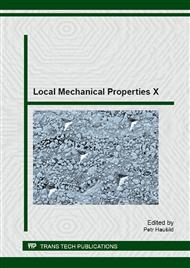[1]
V. Sklenicka, K. Kucharova, M. Pahutova, G. Vidrich, M. Svoboda, H. Ferkel, Creep in electrodeposited submicrocrystalline nickel and its particle-reinforced nanocomposite, Mater. Sci. Eng. A 462 (2007) 269-274.
DOI: 10.1016/j.msea.2005.12.107
Google Scholar
[2]
M.C. Brandes, K. Kinsel, M.J. Mills, Time dependent, ambient temperature deformation of α and α/β titanium alloys, Proceeding of the 12th International Conference JIMIS 11 (2012) 457-460.
Google Scholar
[3]
C.L. Wang, Y.H. Lai, J.C. Huang, T.G. Nieh, Creep of nanocrystalline nickel: a direct comparison between uniaxial and nanoindentation creep, Scripta Mater. 62 (2010) 175-178.
DOI: 10.1016/j.scriptamat.2009.10.021
Google Scholar
[4]
Y.J. Huang, J. Shen, Y.L. Chiu, J. Chen, J.F. Sun, Indentation creep of an Fe-based bulk metallic glass, Intermetallics 17 (2009) 190-194.
DOI: 10.1016/j.intermet.2008.09.014
Google Scholar
[5]
M.J. Mayo, W.D. Nix, A micro-indentation study of superplasticity in Pb, Sn, and Sn-38 wt% Pb, Acta Metall. 36 (1988) 2183-2192.
DOI: 10.1016/0001-6160(88)90319-7
Google Scholar
[6]
R. Raman, R. Berriche, An investigation of the creep processes in tin and aluminium using a depth-sensing indentation technique, J. Mater. Res. 7 (1992) 627-638.
DOI: 10.1557/jmr.1992.0627
Google Scholar
[7]
J. Chen, S.J. Bull, The investigation of creep pf electroplated Sn and Ni-Sn coating on copper at room temperature by nanoindentation, Surface & Coatings Technology 203 (2009) 1609-1617.
DOI: 10.1016/j.surfcoat.2008.12.007
Google Scholar
[8]
Y. Liu, Ch. Huang, H. Bei, X. He, W. Hu, Room temperature nanoindentation creep of nanocrystalline Cu and Cu alloys, Materials Letters 70 (2012) 26-29.
DOI: 10.1016/j.matlet.2011.11.119
Google Scholar
[9]
M.E. Kassner, Fundamentals of creep in metals and alloys, second ed., Elsevier, Oxford, (2009).
Google Scholar
[10]
W. Blum, P. Eisenlohr, A simple dislocation model of the influence of high-angle boundaries on the deformation �ehavior of ultrafine-grained materials. Journal of Physics 240 (2010) 1-4.
DOI: 10.1088/1742-6596/240/1/012136
Google Scholar
[11]
K. Sawada, K. Kubo, F. Abe, Creep behavior and stability of MX precipitates at high temperature in 9Cr-0. 5Mo-1. 8W-VNb steel, Mater. Sci. Eng. A 319-321 (2001) 784-787.
DOI: 10.1016/s0921-5093(01)00973-x
Google Scholar
[12]
K.V. Ivanov, E.V. Naydenkin, Grain boundary sliding in ultrafine grained aluminium under tension at room temperature, Scripta Mater. 66 (2012) 511-514.
DOI: 10.1016/j.scriptamat.2011.12.039
Google Scholar
[13]
Y. Wei, A.F. Bower, H. Gao, Enhanced strain-rate sensitivity in fcc nanocrystals due to grain boundary diffusion and sliding, Acta Mater. 56 (2008) 1741-1752.
DOI: 10.1016/j.actamat.2007.12.028
Google Scholar


